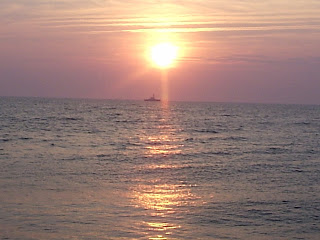This is something I originally penned back in August 2005:
I
Dusk settled on the lake. I could hear the kiss of bluegills as they sucked down insects struggling on the surface.
A few lightning bugs flashed above the mirrored surface. Attracted by their own reflections, they swooped ever closer to the lightning bugs flashing below them.
Fish may not be smart, but they're not all get-out stupid, either. And a bluegill will jump if hungry enough. A few were hungry enough. And inside their bellies glowed a few foolish lightning bugs.
II
Lightning bug light is cool-literally. Luciferin combines with ATP, the energy molecule of life--the resulting compound combines with oxygen, catalyzed by luciferase, and light results. Even tiny amounts of ATP will cause luciferin to light, as long as oxygen is present.
While man has never been to Mars, bits of lightning bugs have--luciferin is an extremely sensitive detector of ATP. If it flashes, carbon-based life may be present.
The price of lightning bugs reached an all-time high this summer: $12 an ounce.
With the advent of luciferase manufactured via genetic engineering, though, the run on lightning bugs may not last much longer.
III
My daughter dug out a tiny mudhole for me in our backyard. At dusk, I sit and read opposite the pokeweed I am learning to like, under a stray white birch I have always liked. Lightning bugs arise from the earth, flashing their "J"'s, looking for love. Harry Potter makes sense sitting outside on a warm July evening.
I read until the dusk chases words off the page, my feet resting on a small stone wall we built together.
A flash just below my right foot.
I break from Harry Potter to anticipate the courtship. A second scurrying critter rumbles about the flash. The flashing becomes frantic, several short blips in less than a few seconds. My eyes adjust--a spider dances around its prey.
I've never seen a lightning bug flash quickly like that, but then I've never seen one eaten by a spider either. A lightning bug makes a flash by adding a tiny bit of ATP to luceferin.
In our mechanistic view of the world, not a bad worldview if you're in the business of conquering it, lightning bugs flash instinctively. They are not known to flash for defensive purposes or fear.
I cannot know why this one flashed, but I do know that lightning bugs, at least this one, had a pattern distinct from its cherchez la femme mode when struggling with a spider.
I almost did not try to "save" it--a good naturalist observes, does not interfere. The spider has as much a right to the meal as I do to mine. Death by spider is likely to be quicker than death by starvation if the critter could no longer fly.
I pulled the frenetically flashing bug out of the web--a white wisp of web stuck to its backside. I set it on a leaf of the birch with mixed feelings. It will die slowly because my imagination would not allow me to let the spider bite it.
As the critter struggled with its first pair of legs to grasp the edge of the leaf, I gently pulled back the stick. The spider silk stuck to my stick. The lightning bug scootched a few millimeters, no longer flashing, and stood still.
I watched a moment longer. The lightning bug raised its beetley shell, opened its wings, and flew away.
A moment later, a lightning bug brushed my leg at the bottom of its "J". No way to know if it was the same one. And it really doesn't matter.
IV
Some Asian lightning bugs flash in unison. The lightning bugs in the Jersey area, at least the ones that make a "J", are not known to do this (according to the scientists). Oh, occasionally they'll accidentally flash together a few seconds after the flash of a bright light, as though they were all resetting their bellies after seeing a god, but left alone, our fireflies are supposed to be the individualistic sorts.
The local critters must be illiterate--once or twice a dusk, they amuse themselves with synchronous flashing. ("Amuse" sounds like anthropomorphizing, of course--it's an interesting word, comes from the French amuser, "to stupefy"--we're most amused when our brains are buggy.) .
V
One poor fellow one evening couldn't turn off his belly --he'd glow properly enough in his "J", but still fizzled a bit as he looked for a response--doubt he could see much light beyond his perpetually lit self.
I muttered "padiddle."
VI
Lightning bugs are, obviously, alive. They have a lot of ATP. They have a lot of luciferin and luciferase. We made lightning bug earrings, lightning bug drawings, we'd smear dying and dead lightning bugs over our faces and laugh and scream like the atavistic creatures we were, mock Indian war paint.
VII
I am a science teacher; I am not a scientist. Like the President, a lot of folks are confused about what constitutes science. We want children to be amazed. You can purchase, via PayPal, a lightning bug "collection system." You have a choice of sizes, and the handle glows in the dark. Imagine that! No doubt safer than punching holes in a half-rinsed mayonnaise jar.
Kids can study and be fascinated by all the little bugs found in the average back yard. Firefly lanterns allow children to watch the lighnting [sic] bugs light up. The bugs can be returned to nature where they were found after a day or two of enjoyment.Plum Creek Marketing Entomology Products for Kids.
Another "experiment" suggests that kids catch lightning bugs in a jar for 5 minutes, record their observations, then let them go.
Took me 40 years to realize I learn a whole lot more doing nothing, feet up on a tiny stone wall next to my daughter's puddle.













































